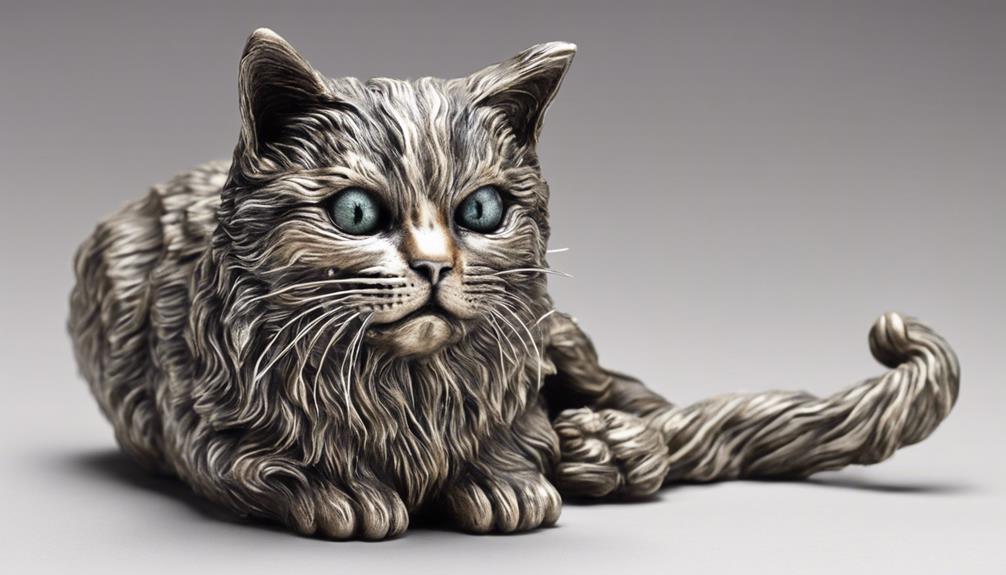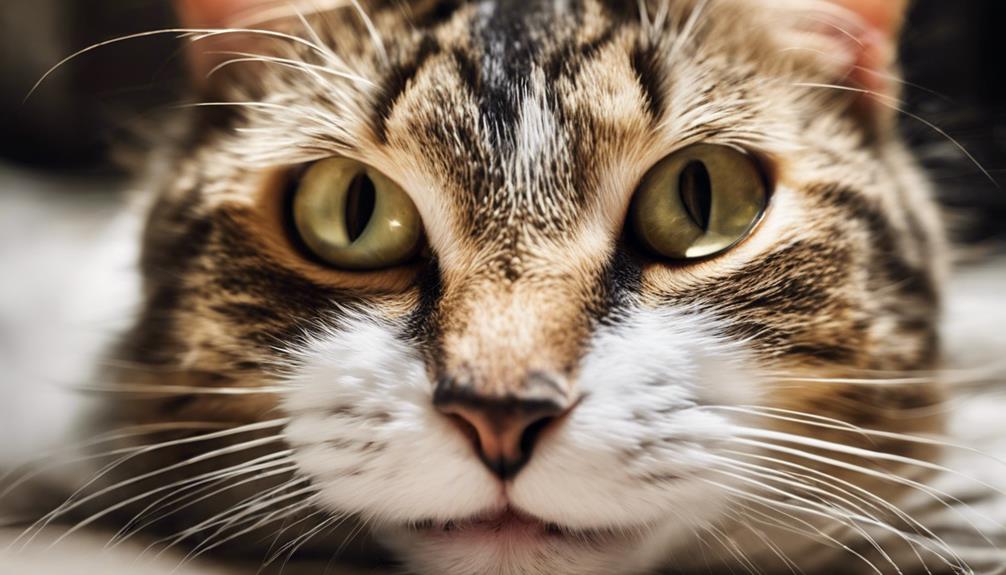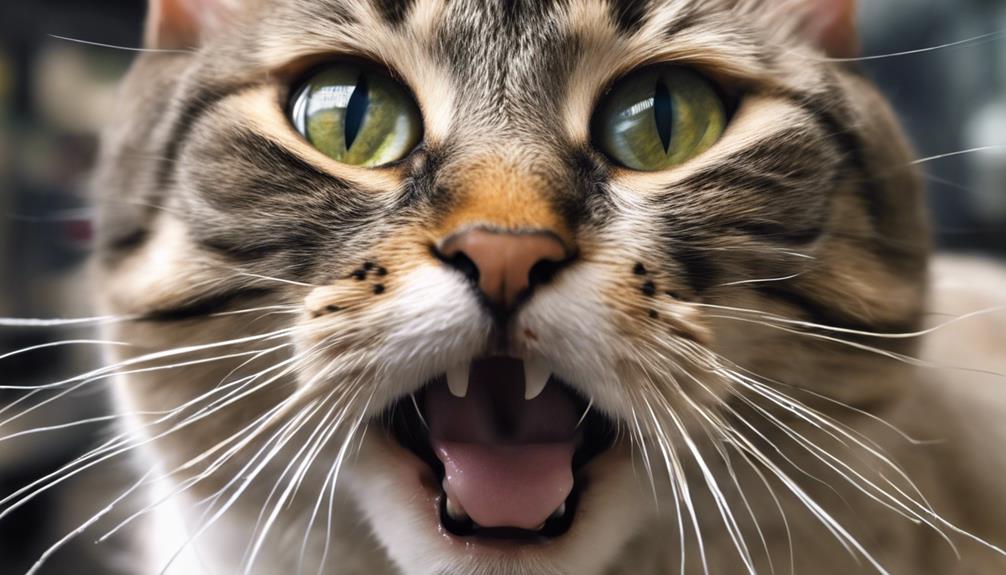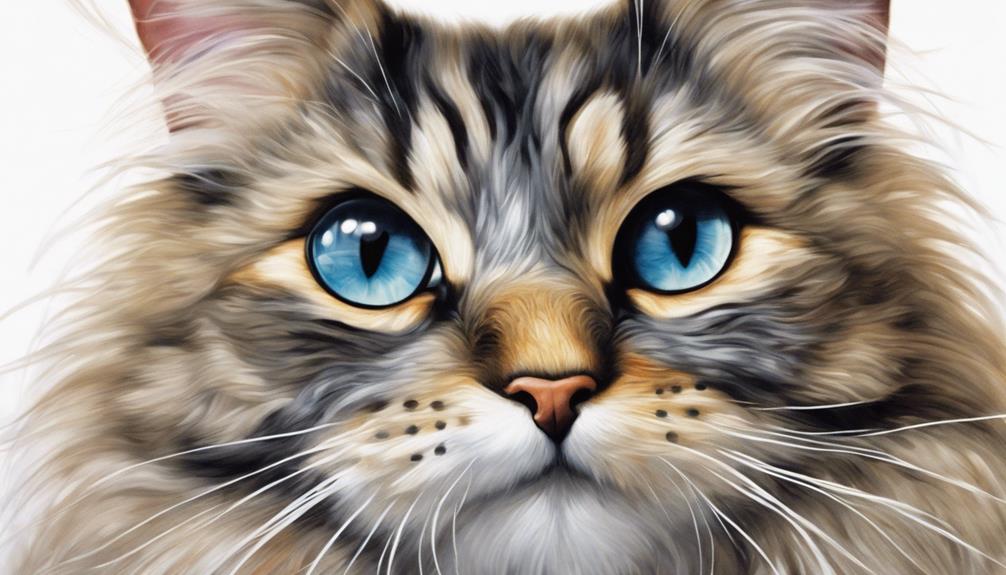When cats trill when you touch them, it’s their way of showing joy, affection, and contentment. This unique form of communication strengthens the bond between feline companions and humans, like little love notes expressing positive emotions. Trilling helps convey their happiness and comfort, seeking attention, and deepening their connection with you. The sound of a trill is their way of saying they are happy, affectionate, and feel safe with you. Understanding this behavior helps foster a stronger relationship with your cat and promotes a deeper connection. Further exploration will reveal the fascinating science behind this heartwarming gesture.
Key Takeaways
- Cats trill when touched to express joy and affection.
- Trilling signifies positive emotions and affection.
- It's a form of communication to strengthen the bond with humans.
- Cat trilling conveys contentment and happiness.
- Touch elicits trilling as a sign of comfort and connection.
Trilling Behavior in Cats
When cats are touched, they often trill as a way to express their joy and affection. This adorable behavior is a clear sign of the positive emotions our feline friends experience when receiving physical attention. Cat trills are like little love notes, indicating contentment, pleasure, and a desire for more interaction. It's their way of saying, 'I love this, please keep going!'
Our furry companions use touch-induced trilling as a form of communication to convey their happiness and comfort. When your cat trills in response to your touch, it's a beautiful reaffirmation of the bond you share. They may be seeking more petting or simply letting you know how much they appreciate your company. This behavior is especially common in social and affectionate cats who thrive on human interaction.
The Meaning of Cat Trilling

Cat trilling serves as a form of communication for our feline friends, conveying their emotions and responses to touch.
This vocalization often signifies affection and contentment, solidifying the bond between cat and human.
Understanding the meaning behind cat trilling can help pet owners better connect with and care for their beloved companions.
Cat Trilling Communication
Trilling, a distinctive vocalization in feline communication, conveys feelings of contentment, affection, and positive emotions. Cats trill as a form of communication, seeking attention and expressing happiness.
This unique sound, learned from kittenhood, is often used by mother cats to lead and communicate with their kittens. When your cat trills at you, they aren't only showing excitement but also trying to strengthen the bond with you.
This vocalization signifies happiness and comfort, serving as a way for your feline friend to engage and interact with you. So, the next time your cat trills, know that it's their way of expressing affection and greeting you with warmth and love.
Cat Trilling Affection
Do felines trill to express their affection in a unique way? Absolutely! When your cat trills in response to your touch, it's a heartwarming display of love and closeness.
This adorable vocalization isn't just a random sound—it's a clear sign that your cat adores you. By trilling, your feline friend is conveying their happiness, contentment, and strong bond with you. It's their way of saying, 'I feel safe and cherished with you.'
Understanding Cat Communication Through Trills

When cats trill, they're expressing their emotions and communicating with us.
Trills can be their way of greeting us and showing affection.
Understanding these trills helps us connect better with our feline friends and strengthen our bond with them.
Cat Trills Express Emotions
Upon being touched, cats express their emotions through trills, providing insight into their communication methods and feelings towards the interaction. Trilling is a way for cats to communicate their affection and enjoyment of the physical contact.
When a cat trills in response to touch, it signifies a positive interaction, showing that they appreciate the attention given to them. This vocalization conveys their contentment and pleasure, reflecting their happiness and trust in the moment.
Trills as Cat Greetings
Trilling serves as a warm and affectionate way for cats to greet and communicate with others. When your cat trills upon being touched, it's their way of expressing affection and acknowledging your presence.
This gentle sound conveys a positive response, indicating that they enjoy the interaction and feel comfortable with you. By trilling, cats show contentment and a desire for more physical contact, strengthening the bond between you and your feline friend.
Understanding this form of communication helps deepen the connection with your cat and fosters a sense of closeness. So, the next time your cat greets you with a trill, know that it's their way of saying hello and showing their affection towards you.
Trilling: A Cats Touch Response

Cats demonstrate their pleasure and contentment through trilling in response to touch, indicating their enjoyment of the interaction. When we stroke our feline friends and they respond with those adorable trills, it's like a sweet melody of happiness. This form of communication lets us know they're loving the attention and wanting more. It's their way of saying, 'Yes, right there, keep going!'
These touch-induced trills create a special bond between us and our cats, strengthening our relationship and trust. It's heartwarming to see how they express their happiness through these vocalizations. Affectionate and social cats often trill in response to touch, showcasing their pleasure in the moment.
The Science Behind Cat Trilling

When a cat trills, it's actually using a vocalization communication method.
This behavior serves as a way for cats to express excitement or affection.
Additionally, trilling when touched reinforces the social bond between cats and their owners.
Vocalization Communication Method
How do cats utilize vocalization as a means of communicating pleasure and contentment when touched?
When a cat makes those adorable trilling sounds while being petted, it's their way of expressing pure joy. These positive vocalizations indicate that your feline friend is thoroughly enjoying the interaction.
The melodic trills are like a cat's version of a contented sigh, showing their appreciation for the tactile sensation of your touch. By trilling when touched, cats provide positive reinforcement, reinforcing the bond between you and them.
Social Bonding Behavior
Trilling when touched by humans showcases a cat's innate ability to express affection and strengthen social bonds through vocalization. When a cat trills in response to touch, it's like a warm hug in cat language. Here's a peek into the feline world of affection and communication:
- Trilling signifies a cat's contentment and happiness in your presence.
- Affectionate trills are a way for cats to show they feel safe and loved.
- Through trilling, cats build trust and deepen their bond with their human companions.
- This form of vocalization reinforces the positive association between touch and pleasure for your furry friend.
Expressing Excitement or Affection
In understanding cat trilling when touched, it reveals insights into the science behind feline communication and emotional expression. When a kitty makes those adorable trilling cat sounds as you pet them, it's their way of showing affection and expressing excitement.
It's like their little way of saying, 'Hey, I'm happy you're here and giving me attention!' This sweet sound means they're happy and content in that moment, enjoying the bond they share with you. Cats have their unique ways of communicating, and trilling when touched is one of those special ways they express their joy.
Trilling: An Expression of Feline Affection

When cats trill in response to touch, they're effectively expressing their affection and contentment in that moment. This sweet sound is their way of saying they enjoy your presence and the interaction. Here's a glimpse into what your feline friend might be feeling when they trill:
- Pure Joy: The trilling signifies sheer happiness and pleasure at being touched by you.
- Deep Connection: It's a sign that your cat values your touch and the bond between you two.
- Comfort and Security: Trilling when touched shows that your cat feels safe and content in your care.
- Love and Appreciation: Each trill is a little declaration of affection and gratitude for your attention.
Exploring the Trilling Sound

When we hear our feline friends trilling, it's their way of expressing joy and connection with us.
This unique vocalization is like a secret code for happiness in cat language.
Understanding the meaning of trilling helps us decipher our cats' communication methods better.
Meaning of Trilling
Upon hearing a cat trill, one can discern a harmonious blend of meow and purr, conveying various positive emotions and intentions. Trilling is a unique way for cats to communicate their feelings, often associated with affection and excitement. Here are some key aspects of the meaning behind a cat's trilling:
- Expressing affection towards their owners or other animals.
- Signaling excitement, especially during playtime or when anticipating a treat.
- Initiating interaction and seeking attention from their human companions.
- Communicating contentment and happiness in their environment.
Understanding these nuances can help us forge stronger bonds with our feline friends and respond appropriately to their needs and emotions.
Cat Communication Method
Trilling, a unique form of cat communication that blends meowing and purring, provides insight into feline emotions and intentions.
When your cat trills in response to your touch, it's a heartwarming display of affection and connection. This delightful sound is their way of expressing happiness, comfort, and a desire for more interaction with you.
The trilling isn't just a random noise; it's a positive response, a sweet melody that signifies the bond between you and your furry friend.
Trilling: A Sign of Cat Contentment

Experiencing a cat's trill when touched serves as a heartwarming confirmation of their contentment and joy. It's a beautiful moment that showcases the bond and affection they feel towards you. When a cat trills while being petted, it's like a little love song just for you.
Here are some ways in which a cat's trill reflects their contentment:
- Expressing Happiness: The gentle trill is a clear sign that your cat is happy and content in that moment.
- Affectionate Connection: Trilling while being touched is a way for your cat to show their affection and deep connection with you.
- Enjoying the Interaction: The joyful trill indicates that your cat is enjoying the physical contact and appreciates the attention.
- Positive Emotional Response: It signifies a positive emotional response to your touch, letting you know that your cat feels safe and loved.
Trilling as a Form of Cat Interaction

When cats trill as a form of interaction, they're actively engaging in a communicative behavior that reflects their satisfaction and enjoyment of physical contact. Trilling when touched is a way for our feline friends to express their happiness and affection towards us. It's their unique way of saying, 'I love this moment with you.' This form of cat interaction is a beautiful display of their contentment and comfort in our presence. When your cat trills while being touched, it's a clear sign that they appreciate the affection and attention you're giving them.
These delightful trills serve as a bonding experience, strengthening the connection between you and your cat. Through this interaction, cats communicate their joy and gratitude, creating a warm and loving atmosphere. So, the next time your furry companion trills in response to your touch, know that it's their way of saying, 'I cherish these moments with you.' Embrace these heartwarming gestures of affection, and continue nurturing the special bond you share with your cat.
The Relationship Between Trilling and Touch

Upon receiving physical affection, cats often express their contentment and pleasure through trilling, signifying a positive association with touch and a desire for further interaction. When our feline friends emit that delightful trilling sound, they aren't only enjoying the moment but also communicating with us, their beloved humans.
This form of vocalization serves as a charming way for cats to express their desire for more petting and attention, deepening the bond between us. The sweet melody of their trill conveys not just happiness but also a genuine longing for continued interaction. As they serenade us with their unique sound, cats are basically saying, 'I love this, please don't stop!'
This communication through trilling when touched showcases their trust and comfort in our presence, creating a heartwarming connection that strengthens our relationship. So, next time your furry companion trills in response to your touch, know that it's their way of saying, 'I adore you, and I want more of this wonderful interaction.'
Cat Trilling: A Sign of Happiness

Cat trilling, a delightful vocalization often expressed when touched, serves as a clear indicator of a cat's happiness and contentment. When our feline friends trill in response to our touch, it's a heartwarming sign that they are feeling joyful and at ease. This unique form of communication allows cats to express their positive emotions, conveying a sense of pleasure and comfort in the interaction. Here is a simple breakdown to help you understand the connection between cats, trilling, and happiness:
| Cats | Trilling | Happiness |
|---|---|---|
| React positively to touch | Indicates enjoyment | Sign of contentment |
| Feel safe and comfortable | Expresses pleasure | Shows happiness |
| Strengthens bond with humans | Reflects positive emotions | Indicates joy |
The next time your cat trills when you pet them, take it as a beautiful affirmation of the happiness they feel in your presence. Embrace these moments of connection as they deepen the bond between you and your furry companion.
The Bonding Role of Cat Trilling

Trilling serves as a heartwarming affirmation of the strong emotional connection between humans and their feline companions. When a cat trills in response to being touched, it's not just a sound; it's a beautiful display of the bond shared between you and your furry friend. Here's how cat trilling plays an important role in strengthening this special connection:
- Expressing Affection: Cat trilling is a way for your feline companion to show you affection and happiness, letting you know they appreciate your presence.
- Building Trust: Through trilling, cats communicate their trust in you, feeling safe and secure in your company.
- Enhancing Bond: This unique form of communication reinforces the bond between you and your cat, deepening the emotional connection.
- Creating Joyful Moments: Cat trilling not only brings happiness to your cat but also adds moments of joy to your shared experiences, fostering a stronger relationship.
Understanding the bonding role of cat trilling can enrich your relationship with your cat, creating moments of warmth and connection that are truly special.
Cat Trilling: Seeking Attention and Affection

When touched, cats trill to express their desire for attention and affection from their owners. It's their way of letting us know they enjoy our company and appreciate the physical connection.
This gentle sound is a positive response, indicating contentment and pleasure in the moment. By trilling when touched, cats communicate their enjoyment of the interaction, seeking to strengthen the bond between us.
This behavior showcases their comfort and trust in us, showing that they feel safe and loved. When your cat trills in response to your touch, it's a heartwarming sign of their affection and connection to you.
Decoding Your Cats Trilling Behavior

Understanding the reasons behind a cat's trilling behavior when touched can provide valuable insights into their emotions and communication style. When your feline companion trills in response to your touch, they're expressing a range of feelings and intentions through their body language.
Here are some key points to help decode your cat's trilling behavior:
- Body Language: Pay attention to your cat's body posture when they trill. Relaxed and positive body language often accompanies trilling, indicating their contentment.
- Affection Towards You: Trilling when touched is a way for your cat to show affection towards you. It signifies that they enjoy your company and the physical interaction.
- Communication of Comfort: Cats may trill when touched as a way to communicate their comfort and happiness with the tactile stimulation they're receiving.
- Bonding and Affection: Trilling behavior when touched is a means for cats to strengthen their bond with you. It serves as a form of communication that enhances the human-cat relationship.
Trilling: Enhancing the Human-Cat Connection

By fostering a deeper connection through touch, cat owners can strengthen their bond with their feline companions. When our cats trill in response to our touch, they're expressing pleasure and contentment, showing us that they enjoy the physical interaction. This vocalization is a way for them to communicate their positive feelings towards us, reinforcing the affection they feel.
As we engage with our cats through touch and they respond with trilling, it deepens the connection between us, creating a sense of trust and security. This mutual exchange of touch and trilling signifies that our cats appreciate our presence and seek out closeness with us. Understanding and responding to their trilling can enhance our relationship with them, making them feel loved and cared for.
Frequently Asked Questions
Why Does My Cat Trill When I Pet Him?
When we pet our cat, they trill to express joy and comfort. It's their way of saying they love the attention. Trilling reinforces our bond, showing their contentment and desire for more affection.
Why Does My Cat Chirp When I Touch Him?
When we touch our cats, they chirp to express joy and connection. It's their way of telling us they're happy and enjoying the interaction. It's a heartwarming sound that strengthens our bond with them.
What Does It Mean When a Cat Trills?
When a cat trills, it shows their happiness and connection with us. Trilling is their way of saying "I love you" and seeking affection. It's a delightful sound signifying comfort and joy in their furry hearts.
Why Do Cats Let You Touch Them?
When we touch cats, they let us because it fosters trust and strengthens our bond. Our gentle touch triggers positive emotions, leading them to trill as a form of communication to show contentment and pleasure.
Does Feeding Cats Pears Cause Them to Trill?
While some cats may enjoy pears, there is no evidence to suggest that feeding cats pears causes them to trill. In fact, the effects of cats eating pears information is limited. It’s always best to stick to a balanced diet specifically formulated for your feline friend.
Conclusion
To sum up, cat trilling is a captivating behavior that serves as a form of communication between cats and their human companions. While some may dismiss it as mere noise, understanding the meaning behind these trills can deepen the bond between you and your feline friend.
By paying attention to your cat's trilling and responding with affection and attention, you can strengthen your relationship and enhance the unique connection you share. So next time your cat trills, remember, it's their way of seeking your love and attention.










